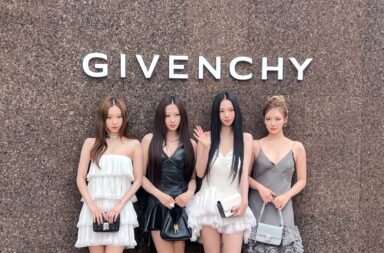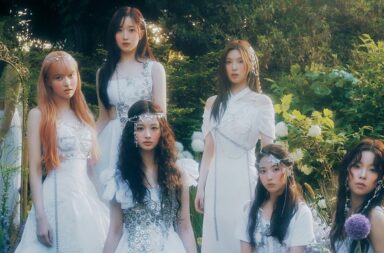 2NE1 has finally made a comeback with a reggae-influenced song in “Falling in Love.” But unfortunately, what’s not so great about this comeback is YG Entertainment insatiable appetite for grabbing “inspiration” from other cultures. We’ve talked about Big Bang and hip-hop in general and Cube Entertainment with both Beast and 4minute stepping into the South Asian zone and horribly misrepresenting Desi culture. Well 2NE1’s done something similar with Sandara Park‘s recent bindi usage. And it’s not even the first time that she’s done this (“Fire”).
2NE1 has finally made a comeback with a reggae-influenced song in “Falling in Love.” But unfortunately, what’s not so great about this comeback is YG Entertainment insatiable appetite for grabbing “inspiration” from other cultures. We’ve talked about Big Bang and hip-hop in general and Cube Entertainment with both Beast and 4minute stepping into the South Asian zone and horribly misrepresenting Desi culture. Well 2NE1’s done something similar with Sandara Park‘s recent bindi usage. And it’s not even the first time that she’s done this (“Fire”).
At first glance, I know what some of you are thinking: it’s just a gem sticker. What’s the big deal? So let me break it down for you.
What’s happening here is essentially the taking of aspects of culture by another culture, usually the culture with greater power, and it’s done without explicit permission from the original culture to do so. The end result is frequently a misrepresentation of the original aspect. The object loses the initial significance it has, and usually, it becomes something that is accepted as “innovative” or “cool” in the second culture while being something for which to ridicule the original culture.
The bindi is that aspect for Desi culture. When several Hindu women in supposedly “tolerant” cultures put on a bindi and go out for work, for school, just anywhere, it’s not uncommon for them to be peppered with questions and declarations that are just enough to emphasize how much they don’t fit: “What’s that red thing on your forehead?” “Are you bleeding?” “This is America. You should dress like the rest of us since you’re here.” “Why did you come here?”
 I’ve been fortunate in that I haven’t been ridiculed for wearing a bindi. But I’ve been unfortunate in that I haven’t been ridiculed because I’ve been so eager to assimilate into American culture that I was the kid that rubbed off my tilaka after going to the temple if I was going to meet my friends afterwards. I refused to wear bindis out in public despite my mother wanting me to. And I’ve heard the things people say to my mother who proudly continues her traditions to this day.
I’ve been fortunate in that I haven’t been ridiculed for wearing a bindi. But I’ve been unfortunate in that I haven’t been ridiculed because I’ve been so eager to assimilate into American culture that I was the kid that rubbed off my tilaka after going to the temple if I was going to meet my friends afterwards. I refused to wear bindis out in public despite my mother wanting me to. And I’ve heard the things people say to my mother who proudly continues her traditions to this day.
When a Desi girl wears a bindi, there are assumptions made, regardless of how American the rest of her wear is. People surprisingly frequently assume you’re going to be speaking with a foreign accent. They assume that you’ve recently come to the United States. They become defensive because you’re suddenly the embodiment of both the outsourcing they’ve heard of and of the achievement of high-level professions with “supposed” ease, all without saying an actual word to you. So you’ve become smart, un-American, and a threat to a population that considers themselves native to a continent that wasn’t even theirs to begin with: the power of a “sticker.”
When a Western (read: white) girl puts on a bindi and chugs up some nonsense about its relationship with a “third-eye,” she suddenly becomes worldly, culturally sensitive, and a hipster in only the greatest way. She’s adventurous, interesting, and someone you want to know. She even knows that what she’s wearing is called a bindi and may tag it as so in whatever form of social media she chooses, usually with something like ‘grunge’ or ‘namaste.’
Do you see the difference? The thing is, there shouldn’t be a difference. A Desi girl wearing something from her culture should be treated with respect, just like any other person, not ridicule, and definitely not less than a non-Desi girl taking something from another culture. The same should go for any wear specific to a culture that has long since not been in power. Until the day comes when both can go out and be treated at least on the same level, the bindi should be kept to those who have it as part of their heritage and those invited to take part in that heritage.
And some of you may then say, “Well I know this one Indian girl who was okay with me wearing it.” That’s fine. She is welcome to be comfortable with you wearing it. That also isn’t the point. The point is that there are some people of that culture uncomfortable with you wearing it. They find it offensive because from their point of view, you aren’t honoring their heritage. You’re making a mockery of it by keeping it on your forehead and making it a fashion accessory, completely disregarding any meaning behind it or perhaps buying into the new definition created when the object in question was unwittingly transferred. And the issue, once again, is that usually when it is worn, it’s worn with the attempt to be more “exotic” or in some cases “misunderstood,” or “alternative.”
And then we get to Sandara Park. To begin, this isn’t an attack on the 2NE1 member. Goodness knows idols are usually not in charge of what they wear, and 2NE1 is no different. But “Falling in Love” is supposed to be this reggae-pop song. Already it’s unrelated to the Hindu culture. There is also nothing in the surroundings that indicates a Hindu practice or invitation to engage in one. So what is Sandara doing? She’s wearing a bindi. The scenery is near a pool in a location set up to be obviously exotic with the gold lions. With Sandara’s platinum blond hair and fair skin, she’s a picturesque model of Western ideals, just missing a set of blue eyes. Is there a purpose to her wearing a bindi? Clearly no. It’s most likely there as a fashion accessory to reinforce her presence in the surroundings. And that’s the problem: it’s so easily recognized as a fashion accessory associated with exoticism when that’s not its purpose.
It’s gotten to the point where in the Western world, a bindi can be tied back to Hindu culture, no problem. But it’s tied back with the notion that it’s a fashion accessory, not something with meaning, because the prevailing white culture has taken that aspect and re-purposed it for their own needs. It can be fashionable when non-Desis wear it, but when Desis do, it becomes them trying to stick with their heritage in the worst way or a sign of not wanting to get along well with the prevailing culture. Though Sandara Park’s scene with the bindi is short, it was highlighted in her teaser picture, and it’s yet another way that Hindu culture is being displayed incorrectly to a population that isn’t that knowledgeable about the initial culture in the first place. And it’s not like the bindis needed to be there: Dara clearly looked stunning in those scenes, and she could have done without them.
 Probably the most frustrating point about this topic is when those that call out this type of behavior are in turn called out for being discriminatory or hindering the sharing of cultures. But there’s something that needs to be understood. A culture isn’t something that anyone can just pick up and assume whenever they like. It something that takes time and effort to integrate into your identity, perhaps because it’s what you’ve grown up with, perhaps because you’ve lived that lifestyle in a welcoming community for that long. There are aspects that are welcome to be shared, including the bindi, but only if invited to do so by a member of that community. It’s not the same thing as sharing food or music. Neither hold the same religious significance as clothes or decorations specific to a culture like, say, a bindi or a Native American headdress. And reading a page on the significance of an object isn’t sufficient knowledge to allow anyone to use that object. It’s not discrimination. It’s not preventing cultures from being shared because the initial purpose wasn’t to share cultures: it was to fulfill the desire to have a shiny sticker on your forehead to look exotic, not to respect its origins.
Probably the most frustrating point about this topic is when those that call out this type of behavior are in turn called out for being discriminatory or hindering the sharing of cultures. But there’s something that needs to be understood. A culture isn’t something that anyone can just pick up and assume whenever they like. It something that takes time and effort to integrate into your identity, perhaps because it’s what you’ve grown up with, perhaps because you’ve lived that lifestyle in a welcoming community for that long. There are aspects that are welcome to be shared, including the bindi, but only if invited to do so by a member of that community. It’s not the same thing as sharing food or music. Neither hold the same religious significance as clothes or decorations specific to a culture like, say, a bindi or a Native American headdress. And reading a page on the significance of an object isn’t sufficient knowledge to allow anyone to use that object. It’s not discrimination. It’s not preventing cultures from being shared because the initial purpose wasn’t to share cultures: it was to fulfill the desire to have a shiny sticker on your forehead to look exotic, not to respect its origins.
So feel free to use gem stickers anywhere. No really, do. The problem is not with the gem stickers themselves. It’s when they’re identified as bindis and used in a similar manner in order to reinforce Western notions of when bindis are supposedly appropriate that there’s a problem.



